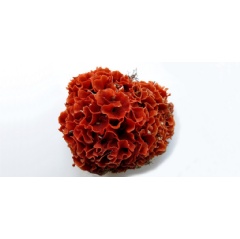Coral-like colonies cause orange growths in historic harbour
A new species of bryozoan – large, orange and coral-like – has appeared in the historic Eastern harbour of Alexandria, Egypt.
’It is very surprising to find a bryozoan this large and visually striking that does not seem not to have been described previously from elsewhere in the world’
The lettuce-like colonies first appeared in December 2015, their crinkly fronds covering submerged objects such as ropes, ships’ hulls and metal pipes.
’It is very surprising to find a bryozoan this large and visually striking that does not seem not to have been described previously from elsewhere in the world,’ says Museum researcher Dr Paul Taylor, who worked on the identification.
The researchers have named the new species Calyptotheca alexandriensis after the famed Egyptian site.
New tenant, old digsAlexandria’s Eastern harbour was created when Alexander the Great founded the city over 2,300 years ago. Originally built for military vessels, nowadays it is predominately used by fishing boats and pleasure craft.
The bryozoans have come and gone since their first appearance two years ago, showing up mostly in winter and early spring. They grow on many submerged surfaces in the shallower harbour waters, and particularly abundantly on the marina’s metal pier supports.
The growth of organisms on structures in the sea is called marine fouling. It is a nuisance to a variety of industries. It accelerates corrosion on buoys and piers, clogs nets and pipes, and increases the drag on ships’ hulls, raising their fuel consumption.
Bryozoans are common in these fouling communities, with one study finding they make up 15% of the species found growing on boat hulls.
Identifying the animalDespite their appearance, bryozoans are animals, not plants. The tiny individuals live in colonies and filter food particles out of the water. Most species attach themselves to a solid surface and remain fixed for the rest of their lives.
The researchers used scanning electron microscopy to examine the features of the bryozoan’s chalky skeleton. While the species was unrecognised, its features indicate that it belonged to the genus Calyptotheca. This genus mainly lives in the warmers waters of the world, particularly the Indo-Pacific ocean regions.
Invasive species in the MediterraneanMany new species have appeared in the eastern Mediterranean in recent decades, helped by warming waters due to climate change. The new arrivals are changing the ecology of the area. Most have entered via the Suez Canal, some by natural drift, others attached to a ship’s hull or in ballast water.
’Non-indigenous and potentially invasive species are common among bryozoans, and there are increasingly frequent reports of new arrivals in ports and harbours around the world,’ says Dr Taylor.
It is possible that the new bryozoan came in via the Suez Canal, given that its origin is likely in the Indo-Pacific and that its closest-looking relative lives in the adjacent Red Sea. It is less than 250km east along the Mediterranean coast from Alexandria to the canal’s entrance at Port Said.
However, the researchers concede the species may have arrived by other routes, as it hasn’t been spotted anywhere further east along the coast towards Port Said.
Undiscovered colonyFor Dr Taylor, the discovery highlights how much more there is to learn about this group of animals.
’The appearance of such a striking and conspicuous bryozoan that we have not previously seen, and whose origin we do not know, just goes to underscore our imperfect knowledge of global bryozoan biodiversity.’
( Press Release Image: https://photos.webwire.com/prmedia/7/213145/213145-1.jpg )
WebWireID213145
This news content was configured by WebWire editorial staff. Linking is permitted.
News Release Distribution and Press Release Distribution Services Provided by WebWire.
